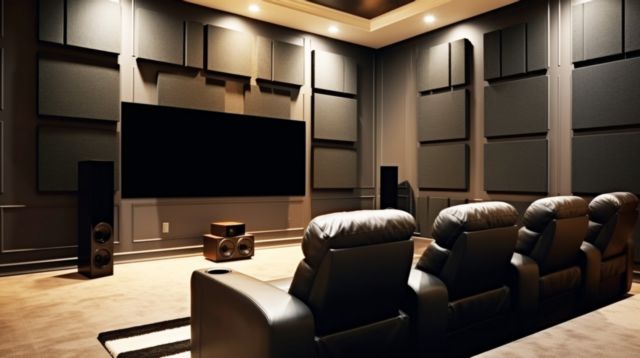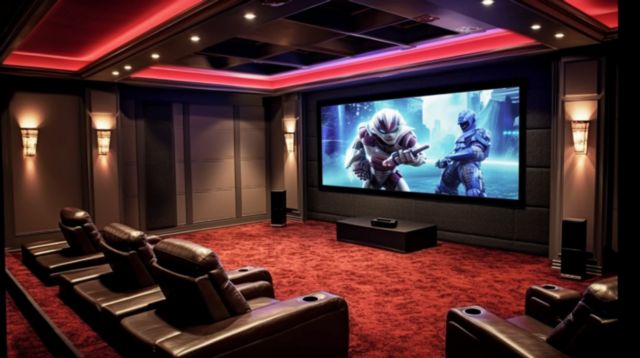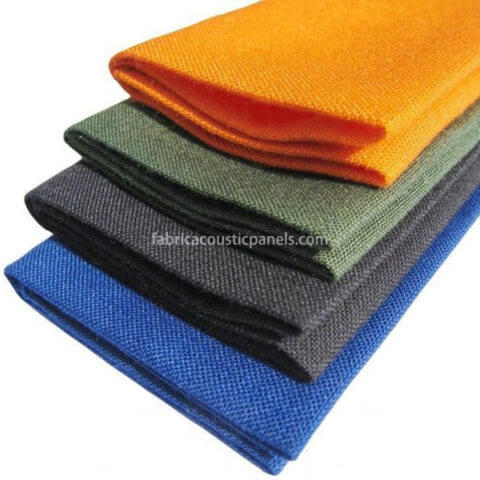I. Introduction
Fabric acoustic panels play a pivotal role in creating an atmosphere that is both visually appealing and acoustically satisfying, not only providing sound absorption but also contributing to aesthetics of a space. A key aspect influencing their visual appeal are acoustically transparent fabrics; in this blog post we will examine various colors and textures available so as to enhance design as well as functionality of fabric acoustic panels.

II. Understanding Acoustically Transparent Fabrics
Acoustically transparent fabrics are specially engineered acoustically transparent materials designed to allow sound waves to pass through while maintaining visual integrity. Constructed using advanced techniques that balance acoustic performance with aesthetic appeal, acoustically transparent fabrics feature microperforations or perforations designed specifically to allow soundwaves through without jeopardizing its structural integrity.
Acoustically transparent fabrics serve to absorb or diffuse sound absorbed or diffused by an underlying acoustic panel while remaining visually appealing and maintaining seamlessness. As opposed to solid fabric that may impair transmission of sound transmission, this acoustically transparent material offers optimal sound absorption and diffusion, making it suitable for applications where both performance and aesthetic design play key roles.
Benefits of Acoustical Transparent Material
Opting for fabric acoustic panels constructed using acoustic transparent material offers several advantages. First of all, they allow for effective sound absorption without hindering the passage of sound waves – something which enables fabric transparent acoustic panels to perform optimally in terms of reducing echo, controlling reverberation and improving speech intelligibility in environments such as recording studios, theaters, conference rooms and restaurants.
Acoustically transparent cloth offers designers and architects many choices when it comes to color and texture. By incorporating these acoustically transparent fabrics into acoustic panel products, it becomes possible to seamlessly integrate these panels into the overall design scheme of any given space. With so many colors and textures to select from, it ensures that not only do the panels fulfill their acoustic purpose but they also add aesthetic charm.
As we explore more deeply the realm of acoustically transparent fabrics and transparent ceiling panels, examining their diverse range of colors and textures as well as understanding how these affect both visual and acoustic aspects of fabric translucent ceiling panels and transparent wall panels, let’s embark on our adventure into discovering their possibilities of creating spaces both acoustically pleasing and visually captivating.

III. Experiment with Different Colors and Textures
Acoustically transparent fabrics offer designers and architects a broad selection of colors to select from, making it easier for them to incorporate fabric acoustic panels seamlessly into any design scheme. From bold and vibrant looks to more subdued aesthetics, there’s sure to be one to match every aesthetic need and preference.
Color can have an enormous effect on the design and atmosphere of a space. Vivid, energetic colors can add energy and excitement, which make them suitable for entertainment venues or creative studios, while neutral tones may create an atmosphere conducive to meditation rooms or healthcare facilities.
When selecting fabric options, it is essential to take into account the existing color scheme and decor of a space. Harmonizing fabric sound transparent panels with surrounding elements can create an aesthetically pleasing environment; using contrasting hues can serve to highlight specific parts of a room or draw the eye’s attention away from unwanted spots in a room.

IV. Texture Options for Acoustically Transparent Materials
Texture plays an essential part in shaping our experience with fabric acoustic panels, both visually and tactilely. Acoustically transparent fabrics offer different textures that add depth and dimension, further elevating their aesthetic appeal.
Textured fabric panels can also impact sound absorption properties in various ways. Different textures can influence how sound waves interact with it, altering absorption and diffusion characteristics accordingly. A fabric with more textured surfaces might scatter sound waves more dispersedly while smoother textures might provide more focused absorption capabilities.
Acoustic transparent cloth comes with various textures that range from woven patterns, embossed surfaces, or custom-designed textures – each offering its own set of visual and acoustic properties that allow designers to select one best suited to its project requirements.
Certain environments, like concert halls or auditoriums, rely heavily on texture choices to meet their desired acoustic performance. When making this selection it is essential that one takes into account their space’s specific sound requirements before selecting an option that aligns with them.
As we continue our exploration of transparent sound absorbing material and fabric transparent ceiling tiles, we will examine their range of colors and textures available – providing inspiration on how to select suitable options for different environments. Don’t miss the next leg of our journey! Stay tuned!

V. Applications of Acoustically Transparent Fabrics
Fabric translucent acoustic panels have many uses in various settings due to their versatility and ability to blend in easily with various design concepts. Here are a few common scenarios in which this fabric type can be found being employed.
Transparent acoustic fabric has many uses in transparent ceiling panels, from sound absorption to creating an open and airy environment. Translucent acoustical baffles are often found in conference rooms, lobbies or retail environments where both acoustic performance and visual aesthetics play an essential role.
Fabric wall panels made of acoustically transparent fabrics are an increasingly popular use of these acoustically transparent materials, serving to both increase room acoustics and add elegance. From recording studios and home theaters to restaurants and more, fabric wall panels featuring these sound-absorbing materials create a more enjoyable auditory experience for customers.
Suspended ceiling tiles also benefit from using fabric materials with sound absorption properties while still looking sleek and modern. By including such fabrics into suspended ceiling tiles, overall acoustic performance of any space can be significantly increased.
Transparent material wall fabrics have become a common component in soundproofing and acoustic treatment projects. By strategically placing these fabrics in areas where sound control is crucial – like recording studios or performance venues – unwanted echos and reverberations can be reduced, creating an environment conducive to high-quality audio production.
VI. Exploring Acoustically Transparent Fabrics
When selecting acoustic fabric manufacturers or suppliers, it’s essential to partner with reliable providers who specialize in materials that meet stringent acoustic performance requirements while remaining visually appealing. These suppliers specialize in producing materials which fulfill these specifications.
Acoustic fabric suppliers can be found both online and through physical stores. Conducting detailed research and reading customer reviews will enable you to identify reliable providers offering a selection of acoustically transparent fabrics. It is key that quality be prioritized over price when selecting suppliers; only fabrics tested for acoustic properties should be purchased from these sources.
Reaching out directly to acoustic fabric manufacturers can offer access to an expanded selection and customization possibilities, often including expert assistance with specific project needs ensuring that acoustically transparent fabrics align with design goals as well as soundproofing objectives.
Acoustic transparent suspended ceiling tiles offer enormous potential to improve both acoustic performance and visual aesthetics in various spaces, and designers and architects can leverage them by exploring various applications with trusted suppliers or manufacturers to craft environments that are both acoustically pleasing and visually stunning. We will discuss additional considerations and tips for using acoustically transparent fabrics effectively in Part III of this series.

VII. Conclusion
In conclusion, fabric acoustical panels play an essential role in both functionality and aesthetics by carefully choosing their colors and textures for both sound absorption and diffusion purposes. Designers can select the appropriate hues and textures to craft visually captivating spaces that also offer optimal sound absorption capabilities.
Acoustically transparent fabrics offer designers endless design opportunities. Ranging from vibrant and energetic hues to soothing and relaxing ones, there is something suitable for every project and desired ambiance. By taking into account existing color schemes and decor in a room, fabric acoustic panels can easily fit in with existing settings and help form cohesive environments.
Texture options in transparent acoustic fabrics add depth and dimension to panels, as they influence how sound waves interact with them and therefore determine its acoustic performance. By choosing textures to meet specific sound requirements in each space, designers can improve absorption and diffusion properties of panels for improved overall sound management.
We urge readers to explore the possibilities of using cheap acoustically transparent fabric in their own acoustic projects, whether for ceiling panels, wall panels, suspended ceiling tiles or soundproofing and acoustic treatment – they offer versatile and functional applications in soundproofing as well as visual aesthetics. By including such fabrics into their design plans they can help achieve an ideal balance between acoustic performance and visual aesthetics.
If you would like more information on fabric acoustic panels and their many available options, we encourage you to reach out to reputable acoustic fabric supplier and manufacturer. They can be invaluable resources in finding materials suitable for your project needs.
Venture into the world of acoustic transparency and take your acoustic design to new heights. Unleash your creativity as you design spaces that not only acoustically please but are visually attractive as well. Together we can transform how we experience sound in our environments.










